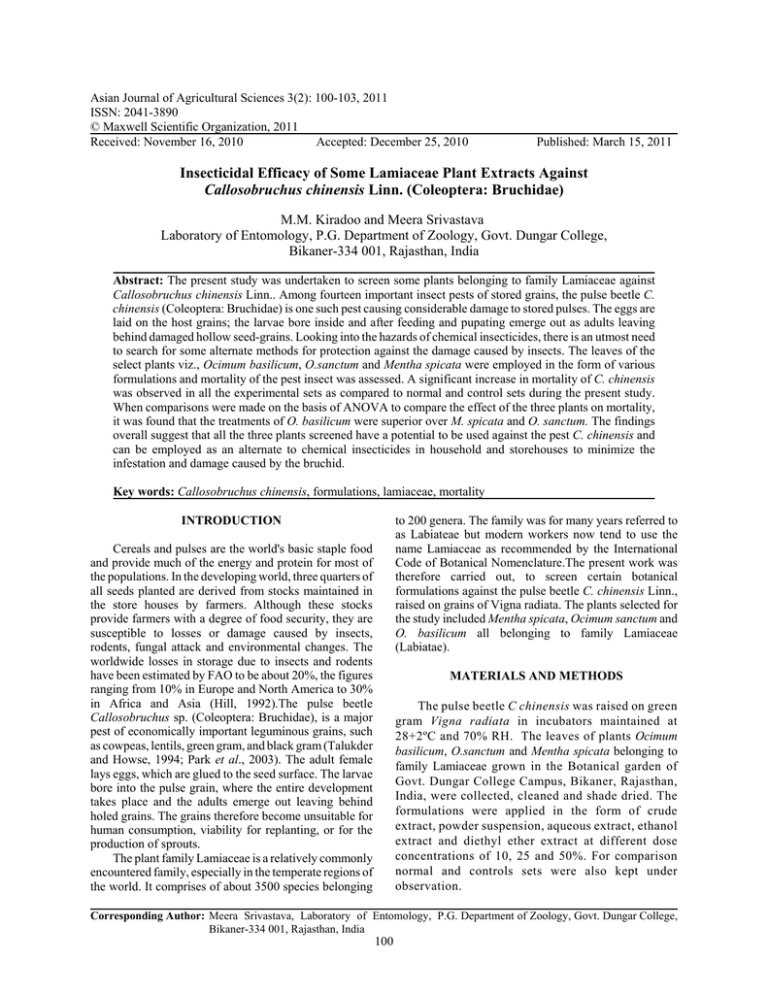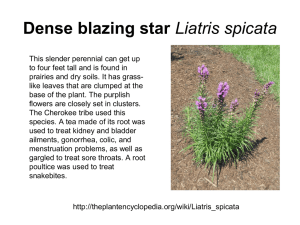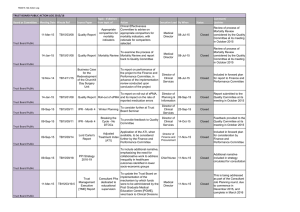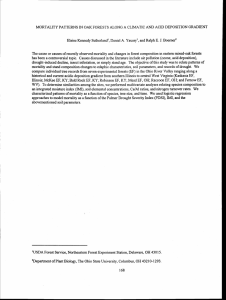Asian Journal of Agricultural Sciences 3(2): 100-103, 2011 ISSN: 2041-3890
advertisement

Asian Journal of Agricultural Sciences 3(2): 100-103, 2011 ISSN: 2041-3890 © Maxwell Scientific Organization, 2011 Received: November 16, 2010 Accepted: December 25, 2010 Published: March 15, 2011 Insecticidal Efficacy of Some Lamiaceae Plant Extracts Against Callosobruchus chinensis Linn. (Coleoptera: Bruchidae) M.M. Kiradoo and Meera Srivastava Laboratory of Entomology, P.G. Department of Zoology, Govt. Dungar College, Bikaner-334 001, Rajasthan, India Abstract: The present study was undertaken to screen some plants belonging to family Lamiaceae against Callosobruchus chinensis Linn.. Among fourteen important insect pests of stored grains, the pulse beetle C. chinensis (Coleoptera: Bruchidae) is one such pest causing considerable damage to stored pulses. The eggs are laid on the host grains; the larvae bore inside and after feeding and pupating emerge out as adults leaving behind damaged hollow seed-grains. Looking into the hazards of chemical insecticides, there is an utmost need to search for some alternate methods for protection against the damage caused by insects. The leaves of the select plants viz., Ocimum basilicum, O.sanctum and Mentha spicata were employed in the form of various formulations and mortality of the pest insect was assessed. A significant increase in mortality of C. chinensis was observed in all the experimental sets as compared to normal and control sets during the present study. When comparisons were made on the basis of ANOVA to compare the effect of the three plants on mortality, it was found that the treatments of O. basilicum were superior over M. spicata and O. sanctum. The findings overall suggest that all the three plants screened have a potential to be used against the pest C. chinensis and can be employed as an alternate to chemical insecticides in household and storehouses to minimize the infestation and damage caused by the bruchid. Key words: Callosobruchus chinensis, formulations, lamiaceae, mortality to 200 genera. The family was for many years referred to as Labiateae but modern workers now tend to use the name Lamiaceae as recommended by the International Code of Botanical Nomenclature.The present work was therefore carried out, to screen certain botanical formulations against the pulse beetle C. chinensis Linn., raised on grains of Vigna radiata. The plants selected for the study included Mentha spicata, Ocimum sanctum and O. basilicum all belonging to family Lamiaceae (Labiatae). INTRODUCTION Cereals and pulses are the world's basic staple food and provide much of the energy and protein for most of the populations. In the developing world, three quarters of all seeds planted are derived from stocks maintained in the store houses by farmers. Although these stocks provide farmers with a degree of food security, they are susceptible to losses or damage caused by insects, rodents, fungal attack and environmental changes. The worldwide losses in storage due to insects and rodents have been estimated by FAO to be about 20%, the figures ranging from 10% in Europe and North America to 30% in Africa and Asia (Hill, 1992).The pulse beetle Callosobruchus sp. (Coleoptera: Bruchidae), is a major pest of economically important leguminous grains, such as cowpeas, lentils, green gram, and black gram (Talukder and Howse, 1994; Park et al., 2003). The adult female lays eggs, which are glued to the seed surface. The larvae bore into the pulse grain, where the entire development takes place and the adults emerge out leaving behind holed grains. The grains therefore become unsuitable for human consumption, viability for replanting, or for the production of sprouts. The plant family Lamiaceae is a relatively commonly encountered family, especially in the temperate regions of the world. It comprises of about 3500 species belonging MATERIALS AND METHODS The pulse beetle C chinensis was raised on green gram Vigna radiata in incubators maintained at 28+2ºC and 70% RH. The leaves of plants Ocimum basilicum, O.sanctum and Mentha spicata belonging to family Lamiaceae grown in the Botanical garden of Govt. Dungar College Campus, Bikaner, Rajasthan, India, were collected, cleaned and shade dried. The formulations were applied in the form of crude extract, powder suspension, aqueous extract, ethanol extract and diethyl ether extract at different dose concentrations of 10, 25 and 50%. For comparison normal and controls sets were also kept under observation. Corresponding Author: Meera Srivastava, Laboratory of Entomology, P.G. Department of Zoology, Govt. Dungar College, Bikaner-334 001, Rajasthan, India 100 Asian J. Agric. Sci., 3(2): 100-103, 2011 Table 1: Adult mortality (%) of C. chinensis under different treatments of leaves of three plants of Lamiaceae Plants -------------------------------------------------------------------------------------------------------------------------Treatments Conc. M. spicata O. sanctum O. basilicum Crude extract Normal 4.44 ± 1.92 4.44 ± 1.92 4.44 ± 1.92 Control 16.66 ± 1.15 16.66 ± 1.15 16.66 ± 1.15 10% 44.44 ± 9.24 55.55 ± 5.45 38.88 ± 9.62 25% 61.11 ± 5.45 55.55 ± 9.61 83.33 ± 6.67 50% 66.66 ± 3.00 83.33 ± 6.67 88.88 ± 9.62 Powder suspension Normal 4.44 ± 1.92 4.44 ± 1.92 4.44 ± 1.92 Control 16.66 ± 1.15 16.66 ± 1.15 16.66 ± 1.15 10% 27.22 ± 9.74 61.11 ± 9.61 61.11 ± 9.61 25% 61.11 ± 9.24 61.11 ± 9.24 66.66 ± 2.10 50% 72.22 ± 5.45 72.72 ± 1.99 83.33 ± 1.00 Aqueous extract Normal 4.44 ± 1.92 4.44 ± 1.92 4.44 ± 1.92 Control 16.66 ± 1.15 16.66 ± 1.15 16.66 ± 1.15 10% 0.00 ± 0.00 11.10 ± 9.61 61.11 ± 9.61 25% 0.00 ± 0.00 16.66 ± 6.66 83.33 ± 6.67 50% 22.22 ± 9.62 22.22 ± 9.24 94.44 ± 9.62 Ethanol extract Normal 4.44 ± 1.92 4.44 ± 1.92 4.44 ± 1.92 Control 33.33 ± 0.57 33.33 ± 0.57 33.33 ± 0.57 10% 94.44 ± 9.62 38.88 ± 6.66 44.44 ± 5.45 25% 100 ± 0.00 49.99 ± 2.08 55.55 ± 9.61 50% 100 ± 0.00 50 ± 2.00 66.66 ± 6.66 Diethyl ether extract Normal 4.44 ± 1.92 4.44 ± 1.92 4.44 ± 1.92 Control 33.33 ± 0.57 33.33 ± 0.57 33.33 ± 0.57 10% 61.11 ± 9.24 44.44 ± 5.45 66.66 ± 6.66 25% 66.66 ± 6.66 55.55 ± 5.45 38.88 ± 1.94 50% 77.77 ± 9.62 66.66 ± 6.66 49.99 ± 6.66 Values given are mean±SD Table 2: Comparison of mean adult mortality (%) under treatments of three Lamiaceae plants Subset ----------------------------------------------Plant types N 1 2 O. sanctum 45 49.6269 M. spicata 45 56.9976 56.9976 O. basilicum 45 65.5522 Sig. 0.146 0.092 Specific number of adult insects were released in muslin cloth covered beakers containing weighed green gram grains and treated with different dose concentrations (w/v). Each experimental set comprised of five replications. The total number of adult insects surviving after three days of treatment in various experimental sets was counted and per cent mortality of adults was calculated. The data obtained was statistically analyzed employing ANOVA using SPSS (2004) analysis. Table 3: Comparison of mean adult mortality (%) under different extracts Subset ----------------------------------------------Formulations N 1 2 Aqueous extract 27 34.5652 Diethyl ether extract 27 58.6389 Powder extract 27 62.8981 Crude extract 27 64.1941 Ethanol extract 27 66.6648 Sig. 1.000 0.267 RESULTS AND DISCUSSION The per cent adult mortality of C. chinensis under different treatments of various plants studied has been presented in Table 1 and Fig. 1 to 5. The results of ANOVA have been presented in Table 2 to 4. During the present study, adult mortality in normal sets was observed to be 4.44 (±1.92)% while, in control sets treated with Glass Distilled Water (GDW), ethanol and diethyl ether (DEE) it was documented as 16.66 (±1.15), 33.33(±0.57) and 33.33 (±0.57)%, respectively. The mean per cent adult mortality as presented in Table 2 with respect to the treatments of leaves of select three plants was 49.62% (O. sanctum), 56.99% (M. spicata) and 65.55% (O. basilicum). A significant (p<0.05) difference in per cent mortality was observed only between treatments of leaves of O. sanctum and O. basilicum. During the present study ethanol extracts were found to be superior over other formulations resulting in higher mortality. 100% mortality was observed in sets treated Table 4: Comparisons of mean adult mortality (%) under different concentrations Subset ----------------------------------------------Concentrations N 1 2 10% 45 47.3676 25% 45 57.0342 50% 45 67.7749 Sig. 0.057 1.000 with 25 and 50% ethanol extracts of M. spicata. 16.66% adult mortality was documented in sets treated with aqueous extract. The present findings are in conformation with those of Stein and Klingauf (1990) who also 101 Asian J. Agric. Sci., 3(2): 100-103, 2011 100 80 100 10% 25% 50% 90 80 10% 25% 50% 70 60 60 40 50 40 20 30 0 Normal Control 20 M. Spicata O. Sanctum O. Basilicum 10 0 Fig. 1: Comparison of adult mortality (%) of C. chinensis under treatments of crude extracts of leaves of three Lamiaceae plants 100 80 Normal Control M. Spicata O. Sanctum O. Basilicum Fig. 4: Comparison of adult mortality (%) of C. chinensis under treatments of ethanol extract of leaves of three Lamiaceae plants 10% 25% 50% 100 60 90 80 40 10% 25% 50% 70 20 60 50 0 Normal Control M. Spicata O. Sanctum O. Basilicum 40 30 Fig. 2: Comparison of adult mortality (%) of C. chinensis under treatments of powder suspension of leaves of three Lamiaceae plants 100 80 20 10 0 Normal 10% 25% 50% M. Spicata O. Sanctum O. Basilicum Fig. 5: Comparison of adult mortality (%) of C. chinensis under treatments of diethyl ether extract of leaves of three Lamiaceae plants 60 40 present study. Kweka et al. (2008) also observed another related species O. suave to result in highest mortality of Anopheles and O. kilimandscharicum of Culex mosquito. Mala and Solayappan (2001) also suggested extract of O. sanctum to cause mortality of 2nd and 3rd instars larvae of Chilo infuscatellus and Roger and Hamraoui (1994) reported hydro-distillated and intact plants of M. piperita, Origanum vulgare, Thymus vulgaris, Satureia hortensis, Rosmarinus officinalis all belonging to family Lamiaceae to be effective in causing adult mortality of Acanthoscelides obtectus. A high kill of adult C. chinensis by the treatment of oil vapours of M. spicata, M. piperita and M. citrata has also been reported by Mishra et al. (1992). The oils of O. vulgare, O. basilicum and O. majorna were found to be lethal to housefly M. domestica by Pavela (2008). All these findings suggest that plants belonging to family Lamiaceae do possess certain insecticidal constituents. It can therefore be concluded that the plants belonging to family Lamiaceae have a potential to be used against C. chinensis, as during the present study the different formulations have been found to bring about significant mortality of the pest insect. 20 0 Normal Control Control M. Spicata O. Sanctum O. Basilicum Fig. 3: Comparison of adult mortality (%) of C. chinensis under treatments of aqueous extract of leaves of three Lamiaceae plants suggested that ethanol extracts of O. sanctum were 60100% effective as botanical insecticide against M. persicae, while, Pascual-Villalobos and Robledo (1998) found polar extract of M. longifolia to produce 70100% mortality when applied topically. The adult mortality in general was found to have a positive correlation with dose concentration. These findings are in agreement with the earlier findings by Ghei (2001), who also found a similar trend, but 10% extracts to be most effective. Gupta (2004) and Mann (1997) also documented a direct relationship of adult mortality with concentration when treated with extracts of various plants. The extracts of leaves of O. basilicum were found to result in highest mortality of C. chinensis during the 102 Asian J. Agric. Sci., 3(2): 100-103, 2011 Mann, A.K., 1997. Evaluation of pesticidal efficacy of certain desert plants against some stored grain pests. Ph.D. Thesis, MDS University, Ajmer, India, pp: 197. Mishra, B.K., P.R. Mishra and H.K. Mahaptra, 1992. Studies on some plant produced mixtures against Sitophilus oryzae (L.) infesting wheat seeds. Ind. J. Plant Prot., 20(2): 178-182. Mala. S.R. and A.R. Solayappan, 2001. Bio-insecticides for the control of early shoot borer Chilo infuscatellus Snell. Proc. NCCP. Udaipur, pp: 38. Park, C., S.I. Kim and Y.J. Ahn, 2003. Insecticidal activity of asarones identified in Acorus gramineus rhizome against three Coleopteran stored - product insects. J. Stored Prod. Res., 39: 332-342. Pascual-Villalobos, M.J. and A. Robledo, 1998. Screening for anti-insect activity in Mediterranean plants. Indus. Crops Prod., 8: 183-194. Pavela, R., 2008. Insecticidal properties of several essential oils on the house fly (Musca domestica L.). Phytother. Res., 22(2): 274-278. Roger, R.C. and A. Hamraoui, 1994. Comparison of the insecticidal effects of water extracted and intact aromatic plants on Acanthoscelides obtectus, a bruchid beetle pest of kidney beans. Chemoecology, 5: 1-5. Stein, U. and F. Klingauf, 1990. Insecticidal effect of plant extracts from tropical and subtropical species. Traditional methods are good as long as they are effective. J. App. Ent., 110(2): 160-166. Talukder, F.A. and P.E. Howse, 1994. Efficacy of Pithraj (Aphanamixis polystachya) Seed Extracts Against Stored-Product Pests. In: Highley, E., E.J. Wright and H.J. Banks, (Eds.), Proceedings of the 6'h International Working Conference on Stored Product Protection, Canberra, Australia, 2: 848-852. CONCLUSION On the basis of ANOVA it could be inferred and concluded that among plants O. basilicum formulations are superior over others, among solvents ethanol extract is better and highest dose concentration of 50% results in maximum mortality C.chinensis. ACKNOWLEDGMENT The Principal Govt. Dungar College, Bikaner, Rajasthan, India is thankfully acknowledged for providing necessary facilities to carry on this work in the Laboratory of Entomology of P.G. Department of Zoology of the College. REFERENCES Ghei, M., 2001. Screening of certain leguminous plants for their insecticidal efficacy against pulse beetle Callosobruchus chinensis Linn. (Coleoptera: Bruchidae). Ph.D. Thesis, MDS University, Ajmer (India), pp: 146. Gupta, L., 2004. Management of pulse beetle Callosobruchus chinensis employing extracts of some solanaceous plants. Ph.D. Thesis, MDS University, Ajmer, India. Hill, D.S., 1992. Pests of Stored Products and Their Control. CBS Publishers and Distributors, India, pp: 274. Kweka, E.J., F.W. Mosha, A. Lowassa, A.M. Mahande, M.J. Mahande, C.P. Massenga, F. Tenu, E.E. Lyatuu, M.A. Mboya and E.A. Temu, 2008b. Longitudinal evaluation of Ocimum and other plants effects on the feeding behavioral response of mosquitoes (Diptera: Culicidae) in the field in Tanzania. Parasites Vectors, 1: 42. 103






